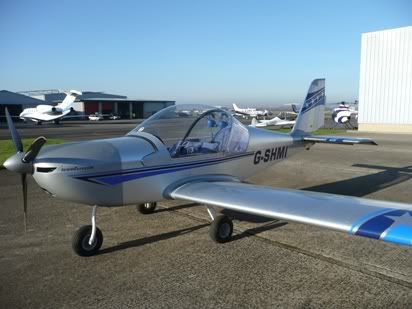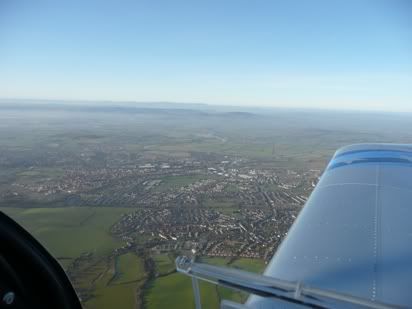It's like making love to a fat woman - it's a lot of fun, but you're too ashamed to tell anyone!
That's me trying to sum up my first experience of flying a microlight, in this case the Eurostar EV97 from Cotswold Aero Club at Gloucestershire Airport.
I have been having withdrawal symptoms for some time now, ever since the group RV6 went into a protracted annual in mid-October. This is now coming to an end, but I can't wait.
So I decided to try some different types on normal 'full hire' rates. They now have a Eurostar microlight and the Robin DR400 on the fleet, neither of which I have flown. A quick toss of the coin and the Eurostar it was.
This has recently been added to the Cotswolds fleet with the collapse of the Skytime flying club on the other side of the airfield. It is owned by Mike Edwards, who is also an instructor, but when I booked I was allocated Roly as the instructor based partly on our combined weights (me 100 kg and Roly a mere slip of a chap) and Mike's non-availability on Sunday afternoon.

The Eurostar arrived from it's previous sortie and Mike Edwards clambered out to confirm the fuel would be fine for me. Roly turned up and showed me the main points of the walkaround. There are a few very important differences as of course this is Rotax powered and a very spartan VFR fit. Being classed as a microlight, it has a MAUW of a mere 450kg (anywhere else in Europe the exact same plane can fly at a far more sensible 544kg - but oh no! Not in good old CAA-land). Still, I expect this will all be addressed by the new EASA legislation - one lives in hope!
The differences on walkaround can be summed up as:
- For the first flight of a day, open the oil cap and pull the prop through until you hear gurgling and the oil registers on the dipstick
- There is only one fuel drain but it is very tricky to operate and you have to have the flaps down to do it.
- There is no way of dipping the tanks, but the gauges are pretty accurate
- DON'T refill with AVGAS, it takes Mogas stored in the hangar
Other than that, it looks at first sight like any other small two-seater. We clambered in and secured the straps. There is no mixture control and no carb heat, but there is a strangely operated choke for cold starting. Oh, and the throttle is spring loaded so that if the throttle friction is not set, the throttle will pull to fully open - a good thing to remember on startup unless you want the plane to surge forward out of control!
Being a Rotax engine, startup was instant (once I read on the checklist to set the magnetos to ON that is). I set the engine revs to a disconcerting 2000 (the reduction gear drops the prop revs to about half that). Anyone used to conventional Continentals and Lycomings etc. will be quite thrown by the high revving engine note as I realised how much I have been flying using non-visual clues like engine note etc.
I should have got a photo of the panel. It is a very spartan and unapologetic VFR fit - no glass panels here! No GPS (eeek - how will I navigate?), Direction Indicator, Artificial Horizon, VOR, ADF, DME etc. It did have a compass, slip indicator, altimeter, Rate of climb, engine monitoring gauges and a handheld radio secured on the panel, but that was about it - accidental IMC in this would be a brief and terrifying experience! No danger of that today though as the early fog had virtually burned off leaving CAVOK, clear skies and nil wind.
We were cleared for the 'long march of death' to 09 - all the way on the other side of the airfield.
The power checks were very straightforward and we were cleared for a right turnout to the south west on 09. I lined up and applied full power. Even loaded to near the limits, the plane surged forward. I didn't quite have the trim right and had to apply forward pressure to hold the nose down as we accelerated quickly. The airspeed indicator is marked in miles per hour and we VERY quickly reached the magic '50' (a piffling 43 kts!), so I relaxed the forward pressure (note this was not really a 'rotate' at all) and the plane shot skywards, possibly even more energetically than the RV!
I climbed at about 85 mph (74 kts) and the ROC showed about a 1000 fpm climb - again, impressive. We climbed to about 2200' and left the power in until about 100 mph (87 kts) then pulled it back to a relaxed cruise rpm (well, for a Rotax that is) of 4500 rpm. The engine note sounded crazy to me as I am used to the old heavy metal, but I guess this is normal for a Rotax. I trimmed the plane out for level flight. The level flight picture looked low to me, but gave excellent visibility. The trim lever is by the flap lever and is very sensitive.
We cleared the airfield environs as Roly got me doing normal turns to get the feel for the plane. It needed a little rudder to get into and come out of the turn and just a bit of pressure to stay in a balanced turn. Without the benefit of an A/I, I would guess I was putting in 45 degree turns.

The up to 3000' to practice slow flight and stalls. Roly got me flying near and then on the 'back side of the drag curve' at 50 mph (a silly 44 kts)! The he asked me to do co-ordinated level turns at this speed. I carefully coaxed it into a co-ordinated turn with careful use of aileron and rudder and managed to maintain height. It didn't so much turn as feel like it was rotating on the vertical!
Then a few stalls. First clean. Roly insisted I held it into a full stall, which I did. There was plenty of warning and the early stages of the stall were simply mushy controls, but as I continued to abuse it, wings started to drop, which I held with rudder. Recovery was simlicity itself, a bit of power and nose down and it was flying again instantly.
The plane is very light and has very little in the way of inertia. This was amply illustrated when I pulled the throttle closed, as there is point in the engine rpm where it positively feels as though someone has thrown an air-brake out!
We spotted and avoided a Cessna and helicopter and as it was busy around the Severn, headed a bit over towards the Malverns.
More stalls with first one then the full stages of flap were even slower and more innocuous, including the simulated 'base to final turn'. Roly explained about the lack of inertia and that the plane had to be positively flown all the way to the hold-off playing with power. We practiced 500 fpm descents holding first 70 then 60 mph as practice approaches.
Then we headed back to Gloucester. I called them and was given a standard overhead join for 27 with right hand circuits. On the approach, Roly spotted an aircraft headed for us at the same level, but just off to our right. A turn to the left put us out of harms way (the normal turn to the right would have put us right across their nose, so not a good idea. The other plane carried on without any sign of recognition, I swear they didn't see us.
We continued approach as I put in a cruise descent. The overhead join went well and the Eurostar can put in a sprightly rate of descent when you want it to. I came across the upwind numbers at the required 1000' and shot the first circuit.
The circuit was quiet. I did my downwind checks, BUMPFFICHLL, but there was so little that applied to this plane it seemed pretty pointless (Brakes: No handbrakes, Undercarriage: Fixed, Mixture: No mixture, Pump: No pump etc.). I left myself a bit high on final and passed the latter part of the approach essentially in a glide descent with an approach speed of 65 mph. I cut the power once in the flare and held off and off. We touched, nice and smoothly. I dropped the flaps, applied full power and I swear in the count of three we were up and flying again.
we quickly gained 1000', then on the downwind leg, the tower gave me a 180 degree left turn to put me on downwind for runway 09 - they had changed runway direction on me in mid-circuit. Given that there was hardly a breath of wind, I did wonder why, but hey, this is ATC and I do what I'm told.
The second landing was again fine, but again, I left myself a bit high with a steep descent. The third and final landing we aimed for the intersection with runway 22, about 2/3rds of the way down 09 and for a 55 mph approach for a short field landing. Well, I was a tiny bit faster than that, but stopped in an amazingly short distance in a nil wind situation. Wow!
Back to Cotswolds and into the lockbox where the Mogas is stored. Between Roly and I we figured out the hand pump and found it to be amazingly efficient as it made short work of a 20 litre jerrycan.
Well, what do I think of it?
It was great fun. It is a very light plane with very little inertia and it responds far quicker than I am used to to power changes. It handles very nicely and is very crisp in roll, sprprisingly so for such small ailerons (again, a very light aircraft). Rate of climb is very sprightly. Landing is fine and easy, but I suspect again because of its light weight that crosswinds might be interesting.
I probably burned a mere 12 litres of Mogas (at 89 pence a litre) in the hour I was flying - a pittance. The high rpm whine of the Rotax will take some getting used to, but that is hardly a major consideration.
Give the Eurostar another 100 kg MAUW and you will have a perfectly practical short-strip tourer on your hands.
I once described flying the Piper Cub as similar to driving a bombed out old mini with no doors around a muddy field. I would describe the Eurostar as driving a go kart - huge fun.
I like it, I like it a lot!
